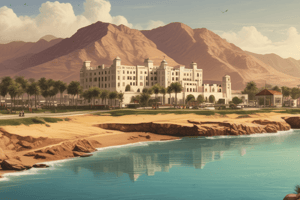Podcast
Questions and Answers
ما هي خصائص فصل الشتاء في شمال ووسط عمان؟
ما هي خصائص فصل الشتاء في شمال ووسط عمان؟
- تساقط الثلوج
- تساقط الأمطار (correct)
- زيادة نسبة الرطوبة
- انخفاض درجات الحرارة
ما نوع المناخ الذي تعيشه سلطنة عمان؟
ما نوع المناخ الذي تعيشه سلطنة عمان؟
- مناخ قاحل (correct)
- مناخ مطير
- مناخ معتدل
- مناخ قاري
من يعيش في المناطق الجبلية في سلطنة عمان؟
من يعيش في المناطق الجبلية في سلطنة عمان؟
- قرويون
- سكان المدينة
- البدو (correct)
- السكان الساحليون
ما هي إحدى التحديات التي تواجه سلطنة عمان فيما يتعلق بالموارد الطبيعية؟
ما هي إحدى التحديات التي تواجه سلطنة عمان فيما يتعلق بالموارد الطبيعية؟
من هو رئيس عُمان؟
من هو رئيس عُمان؟
أي منطقة في عُمان تحظى بأكبر توزيع سكاني نظرً لتوافر الموارد؟
أي منطقة في عُمان تحظى بأكبر توزيع سكاني نظرً لتوافر الموارد؟
ما هي مساحة سلطنة عمان؟
ما هي مساحة سلطنة عمان؟
ما هي طول ساحل سلطنة عمان؟
ما هي طول ساحل سلطنة عمان؟
من أين تبدأ سلسلة جبال الحجر في سلطنة عمان؟
من أين تبدأ سلسلة جبال الحجر في سلطنة عمان؟
كم يتجاوز ارتفاع بعض قمم جبال الحجر في سلطنة عمان؟
كم يتجاوز ارتفاع بعض قمم جبال الحجر في سلطنة عمان؟
ما الذي يفصل جبال الحجر إلى قسمين في سلطنة عمان؟
ما الذي يفصل جبال الحجر إلى قسمين في سلطنة عمان؟
إلى أي جزء ينحدر الهضبة الداخلية في سلطنة عمان؟
إلى أي جزء ينحدر الهضبة الداخلية في سلطنة عمان؟
Flashcards are hidden until you start studying
Study Notes
Geography of Oman
The Sultanate of Oman, situated in the southeastern corner of the Arabian Peninsula, has a diverse and captivating geography. Its total area spans approximately 309,500 square kilometers, making it the third largest country in the Arabian Gulf. The landscape ranges from rugged mountains to vast deserts, fertile coastal plains, and lush oases. Here we explore the unique features of Oman's geography.
Physical Features
Coastlines and Seas
Oman has a coastline of nearly 3,165 kilometers, stretching from the Strait of Hormuz in the north to the border with Yemen in the southwest, overlooking the Persian Gulf, the Gulf of Oman, and the Arabian Sea. Its strategic position makes it a vital player in global maritime trade.
Topography
Three physiographic zones dominate Oman's topography. The long, narrow coastal plain of Al-Batinah runs along the Gulf of Oman. To the northeast, the high, rugged Al-Hajar Mountains stretch from the Musandam Peninsula to a point near Ra's Al-Hadd at the peninsula's easternmost tip. Many peaks in the Al-Hajar Mountains exceed 4,800 feet (1,463 meters), with the highest peak reaching over 10,000 feet (3,000 meters) at Al-Jabal Al-Akhdar.
Inland, a great central divide known as Wadi Sama'il separates the Al-Hajar into two ranges. Further south, the inland plateau falls away to the southwest into the vast Rub'al-Khali (Empty Quarter) desert, which Oman shares with Saudi Arabia and Yemen.
Climate
Oman experiences an arid and semi-arid climate, although conditions differ among regions. Summers are hot and humid in coastal areas, while interior regions are hot and dry, except where temperatures remain moderate throughout the year. Rainfall patterns vary across the country. Winter brings rain in the north and center of Oman, while the southern parts experience a seasonal summer monsoon from June to September.
Human Geography
Oman's human geography reflects its varied physical environment. The coastal city of Muscat serves as the capital and cultural hub, while the interior regions host the traditional Bedouin lifestyle. The mountainous areas are home to distinct communities known as jibalis, who speak South Arabic languages different from the modern standard (North) Arabic spoken on the coast.
The population distribution follows the availability of resources. The northern coastal regions of Al-Batinah and Musandam are densely populated due to their favorable agricultural conditions and access to water resources. The southern region of Dhofar, with its lush alluvial soil and ample rainfall, supports a larger rural population compared to the rest of the country.
Agriculture and Natural Resources
Oman's agricultural sector focuses on both subsistence farming and cash crop production. Five distinct agricultural regions span the country, ranging from the Musandam Peninsula in the north to the Dhofar region in the south. The country boasts significant natural resources, including underground aquifers, which are essential for irrigating crops and meeting water demands.
However, Oman faces challenges related to resource management. Soil degradation due to agricultural practices and urban development threatens fertility in certain areas, necessitating careful conservation efforts. Additionally, the reliance on imported food supplies means that the country must balance self-sufficiency with international trade considerations.
Studying That Suits You
Use AI to generate personalized quizzes and flashcards to suit your learning preferences.




